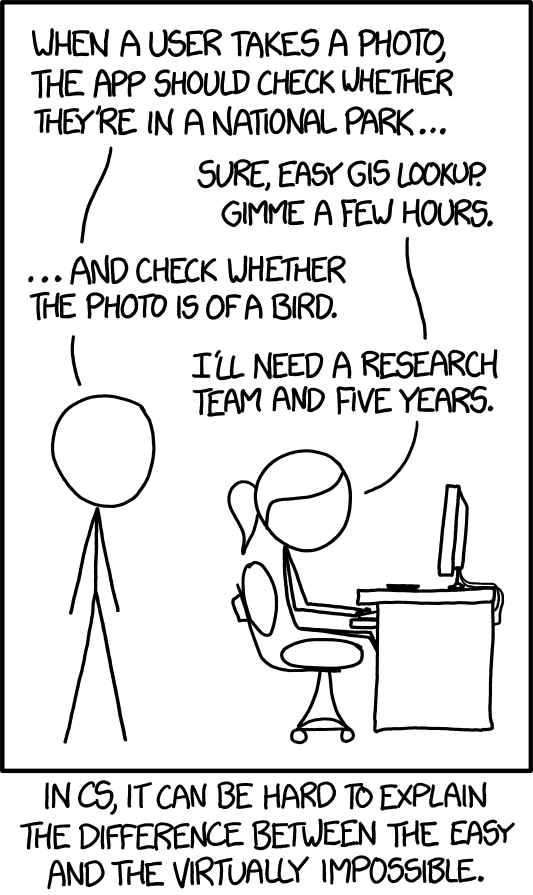We can get a computer to tag the birds, answer questions about them, and generate new pictures of them.
Well research teams have been working on it 10 years
they did good
edit: tbh honest i think it was around 5 years ago i started being able to identify things with google lens on my phone. they worked fast!
And crazy how not only can tools recognize birds but generate novel new images of them.
Exactly!
deleted by creator
that’s awesome, didn’t know that
Damn, I wanted to see some parkour birds.
Damn seeing a serious Flickr link truly is a blast from 10 years ago!
Did you miss the part that said “I’ll need a research team and 5 years?” The XKCD character did it! SUCCESS!
More than 5 years then. The comic was right, with the difference that it took more than 1 single team of researchers to solve it
I have a book on learning Pytorch, this XKCD is in the first chapter and implementing this is the first code practice. It’s amazing how things progress.
Do you recommend that book? Title?
Yes I do! It’s a pretty great overview that isn’t extremely math heavy
The book is “Deep Learning for Coders with Fastai and PyTorch: AI Applications Without a PhD”
Thanks! Not math heavy is good.
Not obsolete? More like prophetic.
Computer vision was just popping off five years after that, so I would say that it is prescient.
Even with AI models that can identify that there are birds in the picture. Having it decide with accuracy that the picture is of a bird is still a hard problem.
It’s actually even more correct because it underestimated the time needed by 5 years
I remember this one. It seems as spot on now as it was then, IMO. It’s not trying to say that object detection is magic or impossible, since it was totally possible then as well. It just requires a dedicated team + time + money to pay them, which is what this comic was trying to express. It is true there are more off-the-shelf software available for newer programmers now than there was before, so dev time is shorter, but that’s more just degrees of comfort / budget as opposed to anything fundamentally different.
That’s true, even if the specific example doesn’t hold, the core concept does. If I needed to implement a bird detector today, I’d make an API call to AWS Rekognition or an equivalent service. It would take me a day or two to learn the API and then maybe 4 hours to actually implement. But if you asked me to implement a bird species detector, I’m pretty sure there is no off the shelf API capable of that, and I would indeed need months or years.
deleted by creator
Google Lens is also a thing for general usage, and there are plenty options for more specific tasks such as Merlin for birds.
I used to put this in my object detection presentations 5 years ago and it never failed to draw chuckles from the audience.
Shit has been going really really fast.
Why do you think it’s obsolete? I suppose nowadays we can use AI generative models to explain the difference between the easy and the virtually impossible, but it still can be hard.
Epilogue: She got what she asked for and completed the work 5 years ago.
One of the coolest things I’ve seen this month: https://www.lerf.io/
Not only is this not obsolete, it’s close to biographical as it closely references the first and second Artificial Intelligence Winters. The first being in the 60s. We’ve been working on these for a long time, so 5 years is short. It took until GPGPU to kick into full gear and some clever insights to get Deep Learning up and running (somewhat attributed to work published in 2011) to start reliably on this problem, and even that is an oversimplification of the timeline and the scope.
Others have mentioned oddities like the difficulty of subject matter (picture contains a bird vs picture of a bird) but there are a lot harder problems that are trivial to humans and counterintuitively incredibly hard for computers.











